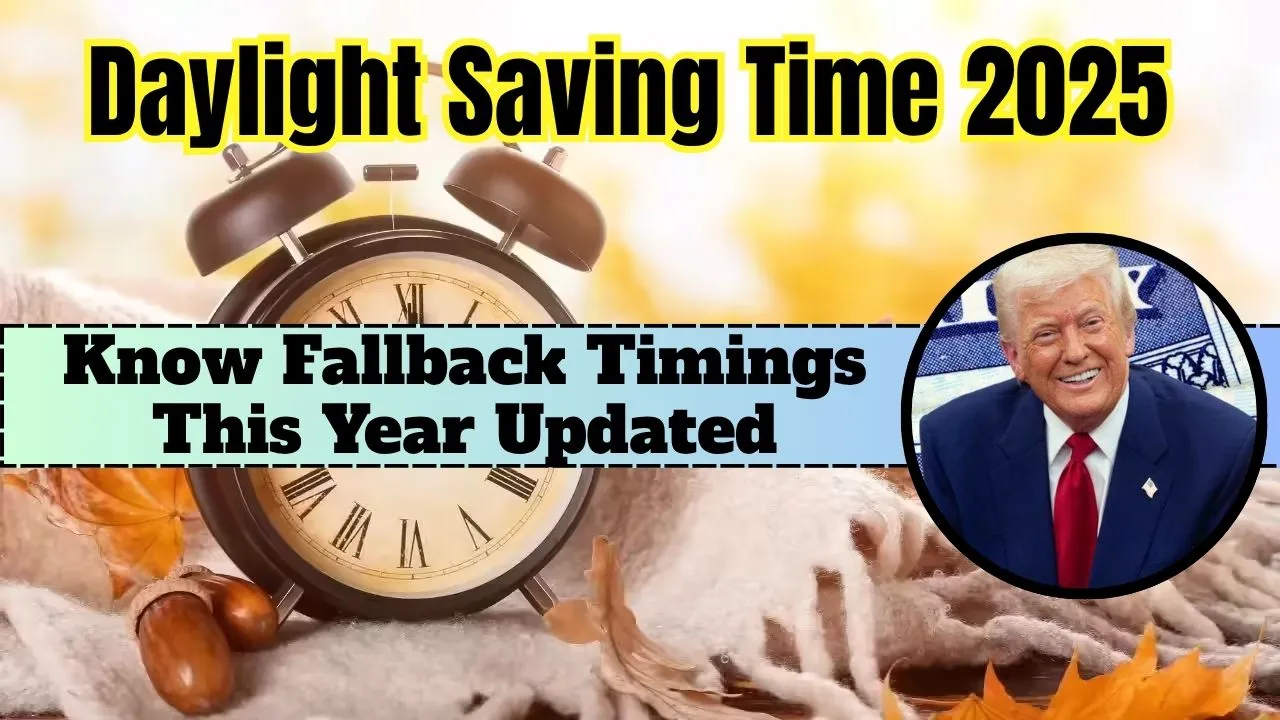Daylight Saving Time 2025 is right around the corner, and people everywhere are preparing to turn their clocks back. If you are someone who loves gaining an extra hour of sleep or just wants to stay on top of time changes, this is one update you do not want to miss. Daylight Saving Time 2025 affects more than just your sleep schedule; it also plays a role in energy usage, health patterns, and even business operations.
In this article, we will break down everything you need to know about the time change this year. From when it starts and ends, to how it impacts different parts of the world, and what debates are going on about whether it should even exist anymore, we have it all covered. Keep reading for the most updated and easy-to-follow guide on the fallback timings.
Daylight Saving Time 2025 – Key Update and Fallback Details
As Daylight Saving Time 2025 comes to an end on Sunday, November 2, 2025, clocks will be turned back one hour at exactly 2:00 a.m. local daylight time. This means you will need to set your clocks back to 1:00 a.m. local standard time. It is that one day of the year when you technically get an extra hour, and it usually results in earlier sunrises and sunsets.
This transition marks the end of DST for the year, which started on March 9, 2025, when clocks were pushed forward. The idea behind this practice is to make better use of natural daylight, but many people are starting to question its effectiveness. Some are pushing for it to be permanent, while others want to eliminate it entirely. Let us look at the essential facts before diving into the wider discussion.
Overview Table – Daylight Saving Time 2025 at a Glance
| Detail | Information |
| End Date | Sunday, November 2, 2025 |
| Time of Change | 2:00 a.m. local daylight time |
| Action Required | Set clocks back one hour to 1:00 a.m. |
| Start Date of DST | Sunday, March 9, 2025 |
| Extra Sleep? | Yes, you gain one hour of sleep |
| Sunrise and Sunset Impact | Both occur one hour earlier starting November 2 |
| Affected Areas | United States, Canada, Europe, Australia, New Zealand |
| Common Debate Topic | Energy savings, health effects, and daily disruption |
| Main Benefit | Better alignment with daylight during standard time |
| Current Status | Still in use, but under review in many states and regions |
Will Daylight Saving Time be Discontinued?
The question of whether Daylight Saving Time 2025 will be the last one we observe is still up in the air. In the United States, there is an ongoing conversation about whether to stick with standard time permanently or shift to daylight time all year. Back in March 2022, the Senate approved a bill to make DST permanent, but it did not pass in the House.
Some leaders argue that the time shift is outdated and disrupts people’s health and productivity. Others believe the longer evening light during certain months is beneficial. About 30 U.S. states have passed or proposed bills to end the biannual clock change, but most are waiting for regional coordination. Until a final decision is made, Daylight Saving Time 2025 continues to follow the same pattern.
Fallback Timings 2025: Important Details
The fallback in Daylight Saving Time 2025 is more than just a clock adjustment. It has real effects on your routine, travel schedules, and even your body’s internal clock. The change happens at 2:00 a.m. local daylight time on Sunday, November 2, 2025. At that moment, clocks roll back one hour, effectively giving everyone an extra hour in the day.
This time shift will result in earlier sunrises and sunsets. While many enjoy the brighter mornings, the trade-off is darker evenings, which can affect evening plans and overall mood. If you have events, flights, or deadlines that weekend, double-check your times to avoid confusion.
Region-Wise Fallback Saving Time 2025
Daylight Saving Time 2025 does not follow a universal schedule. Depending on where you live, the dates and times may be different. In the United States, DST ends on November 2, and the same goes for Canada. In Europe, it wraps up a week earlier, on October 26, 2025, at 1:00 a.m. local time.
In the Southern Hemisphere, it is the opposite. Places like Australia and New Zealand are just beginning DST in late September and early October. Australia’s start date is October 5, 2025, while New Zealand starts even earlier on September 28, 2025. These regions shift their clocks forward, not back, at this time of year, preparing for longer daylight in summer.
Why do we observe Daylight Saving Time?
The original purpose of Daylight Saving Time 2025 is to make better use of natural daylight by moving an hour of daylight from the morning to the evening. It was believed to save energy, increase productivity, and promote outdoor activity. However, the world has changed a lot since this idea was first introduced.
Today, many experts question whether DST truly saves energy. Some studies suggest it may slightly increase electricity use due to heating and cooling needs. Others point to health issues, such as disrupted sleep cycles, heart health risks, and mental health challenges. Still, for now, the practice continues in many parts of the world.
Quick Facts About Daylight Saving Time 2025
- The fallback occurs on November 2, 2025, at 2:00 a.m.
- You set your clocks back one hour
- This means more light in the morning and less in the evening
- It began earlier in the year on March 9, 2025
- Still used in many regions, but its future is under debate
- Some states are pushing for permanent changes
- Not all countries follow DST; it varies widely
- It can affect sleep, travel, tech devices, and even mood
- Businesses and schools often adjust schedules around DST
- Remember to update both manual and digital clocks
FAQs
You should set your clock back by one hour at 2:00 a.m. local daylight time on Sunday, November 2, 2025.
Yes, most smartphones and digital devices update the time automatically if they are set to the correct time zone.
No, many countries do not observe DST. It is mainly followed in North America, Europe, and parts of Oceania.
The idea is to better align waking hours with daylight, though its benefits are now being questioned.
Yes, the time change can temporarily disrupt sleep and may impact mood, concentration, and even heart health.












